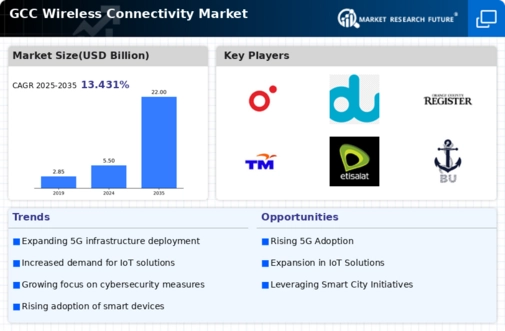Increased Mobile Device Usage
The proliferation of mobile devices in the GCC is a significant driver of the wireless connectivity market. With smartphone penetration rates exceeding 90% in some countries, the reliance on mobile connectivity for various applications is at an all-time high. This trend is expected to continue, as consumers increasingly utilize mobile devices for communication, entertainment, and business transactions. The demand for high-quality wireless services is likely to escalate, prompting service providers to enhance their offerings. Consequently, the wireless connectivity market is poised for growth as it adapts to the evolving needs of mobile users.
Emergence of Smart Technologies
The wireless connectivity market is experiencing a shift due to the emergence of smart technologies, including smart homes and smart cities. As consumers and businesses adopt these technologies, the demand for reliable and high-speed wireless connectivity is becoming paramount. The GCC region is investing heavily in smart city initiatives, with projected spending reaching $20 billion by 2025. This investment is expected to drive the need for advanced wireless solutions that can support the connectivity requirements of various smart applications. As a result, the wireless connectivity market is likely to expand significantly in response to these technological advancements.
Rising Demand for High-Speed Internet
The wireless connectivity market in the GCC is experiencing a notable surge in demand for high-speed internet services. This demand is primarily driven by the increasing number of internet users and the proliferation of smart devices. As of 2025, the region has seen a growth of approximately 15% in internet penetration, leading to a greater need for robust wireless connectivity solutions. Businesses and consumers alike are seeking faster and more reliable internet connections to support activities such as streaming, online gaming, and remote work. This trend is likely to propel investments in advanced wireless technologies, thereby enhancing the overall infrastructure of the wireless connectivity market.
Government Initiatives and Investments
Governments across the GCC are actively investing in the development of digital infrastructure, which significantly impacts the wireless connectivity market. Initiatives aimed at enhancing connectivity, such as the Smart Cities projects, are being implemented to improve urban living standards. For instance, the UAE government has allocated over $1 billion towards enhancing telecommunications infrastructure. Such investments are expected to facilitate the deployment of next-generation wireless technologies, including 5G, thereby fostering innovation and economic growth. The proactive stance of governments in the region is likely to create a conducive environment for the expansion of the wireless connectivity market.
Growth of E-Commerce and Digital Services
The wireless connectivity market is being positively influenced by the rapid growth of e-commerce and digital services in the GCC. As more consumers turn to online shopping and digital platforms for services, the demand for reliable wireless connectivity has intensified. Reports indicate that e-commerce sales in the region are projected to reach $30 billion by 2026, necessitating enhanced connectivity solutions to support this growth. Businesses are increasingly recognizing the importance of seamless online experiences, which in turn drives the need for advanced wireless technologies. This trend is likely to stimulate further advancements in the wireless connectivity market.
















Leave a Comment